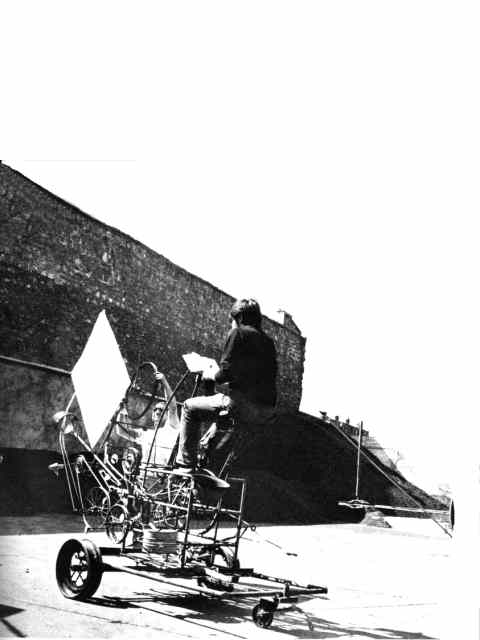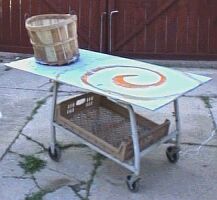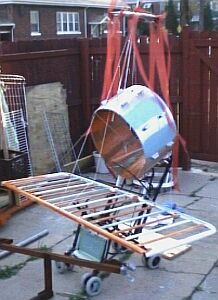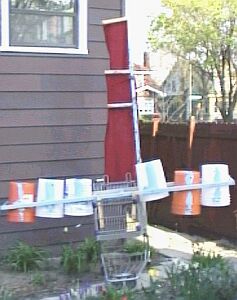Archive: Author: wade tillett
technical systems
network
effect
life
difference
objectification
appendix
abstract
Objectification is our ability to control reality, to place images of ourselves within reality which are independent from ourselves. This is what objectification is about, at the root, is seeing ourselves. Within the void, standing on the infinite beach staring out at the infinite sea, we see only our temporality, our inability to change, to make consequence, to conquer death. And it is by placing within this void images of ourselves that we attempt to assure our own existence.
But it is our ability to control reality, to design, which objectifies our existence, strips our humanity from within us, and fills the void around us, drowning us within our own attempt to see ourselves. We no longer inhabit the void, but rather a void filled with images of ourselves, with markers of existence, with tombstones, churches and photographs. And as we fill this void, as we extract from ourselves our perceptions and our humanity, our life and our beliefs, the only implication can be that we have less within ourselves, that we become void within our objects, spaces between our images of ourselves.
In order to continue our belief that we are non-void, we must inhabit the void. For to be the void inhabiting the non-void is to be nothing; no room is left for humanity and for existence. This thesis builds from the belief that we are non-void inhabiting the void. That by not objectifying ourselves, by not filling the void with non-void, we allow ourselves to exist within the void. By not creating reality we assure our own. By not objectifying our thesis, we leave ourselves with our thesis.
By objectifying our anti-thesis exterior to ourselves, we create the thesis within ourselves. Thus we want to create a world without belief so that we can believe. We want to construct a world of nihilism fulfilled so that we can revel in the fulfillment of our own belief within ourselves.
It is the blank canvas and cold hard examination room, which cause in us the urge of life, the artistic impulse, the kinetic potential. The feeling in the viewer is active and induced rather than empathetic and distant. It is in the coldest and most comfortless rooms that we feel ourselves most. By not imbedding the object with emotion, we leave those unspeakables unspoken, and those undescribables undescribed. The void is more saturated with kinetic potential the more the potential energy is intentionally left untapped.
It is by objectifying as little as needed that we achieve the greatest benefit to ourselves. It is less systems, smaller systems, invisible systems which allow us to achieve the greatest effect while giving up the smallest piece of ourselves. Satellites, radio towers, microwaves, light, sound, these give us the desired effect without clogging our reality with objects. These are the most efficient systems. These utilize the void as a medium, rather than carving out their own chunk of it. They are, in essence, pure effect: the nullification of architecture.
The object must abandon style and embrace the fluid effect. Physical objects can not change fluidly. They leave us with archaic and stagnant images of ourselves. Architecture is obsolete before it is built. Objects must be a system that supports effect. The effect must be total and all encompassing. Minimal design allows for total immersion of a fluid effect. It does not imbed our thoughts within the object.
Objectification produces something that is no longer dependent on our thoughts about it. In fact, it is through their independence from our thoughts about them that real things distinguish themselves from the contents of our minds.12 Reality is the difference between the object and our thoughts about it. Reality is the difference between our thoughts and the objectification of our thoughts. This is the inherent flaw of objectification, of architecture’s thesis: reality is independent of the mind. It is the difference between our designs and the objectification of our designs that allows us to distinguish reality. Reality is the failure of design.
Minimal design makes its own failure extremely evident. It makes the viewer aware of themselves. The person within the room of nothing becomes the difference, the failure, the reality within the design.
abstract
Join the carnival. Another world has begun.
The parade is an actual positive action, creating a positive festival while
simultaneously actually improving the surroundings it marches through.
Just by walking through the neighborhood, the neighborhood improves.
How?
By picking up trash.
We will comb the neighborhood. Pick stuff up off the curbs.
Select beauties from the dumpsters. Pots and pans and
coffee cans and scraps of wood become instruments.
Pop-cans and cardboard and steel and glass become jewelry,
adornments,festive costumes. Bits and pieces and
discarded particles and waste become
reclaimed, a work of art,
participatory amorphous ever-changing.
gimpA decentralized scavenging mass.
 A trash brigade.
A trash brigade.
A path of construction. A positive action.
A gritty, particular community inter-action.
Democracy in action.
Democracy is action.
We are realizing our own power.
Each person, each participant,
is directly changing,
freely creating,
im-mediately acting.
This is HOW we construct
a better world,
by acting
at this very moment.
This is it.
We’re starting right now.
Join the carnival.
Another world has begun.
Bring your tools.
April 28, 2002 10:00 am
Sacramento/Ogden, Chicago, IL
`Volunteer’ requirement rankles residents of public housing
`Volunteer’ requirement rankles residents of public housing
Matt Stearns
September 2, 2003
WASHINGTON – When is volunteer community service not really voluntary? When the federal government threatens to throw you out of your home if you don’t comply.
A rule to be enforced starting in October will require certain public housing residents to perform eight hours a month of community service. Those who refuse such duty face eviction.
Officials say it will affect about 20 percent of the 2 million Americans who live in public housing, because there are exemptions for those with jobs or in school, for the disabled and for the elderly. As many as 900 public housing residents in Kansas City and 300 in Kansas City, Kan., will be affected.
“I think folks have to understand that eight hours a month in exchange for having a roof over your head is an extremely reasonable request,” said Michael Liu, assistant secretary for public and Indian housing at the U.S. Department of Housing and Urban Development.
It also will help people develop skills they can use to find jobs, Liu said.
But critics say the rule discriminates against the poor, will fall disproportionately on stay-at-home parents, and is another unfunded federal mandate issued at a time when public housing authorities are hurting for money. On top of that, they point out, many people who live in public housing do pay some rent.
“People who get a homebuyer’s tax credit also receive federal help,” said Kim Willis, a policy analyst at the National Low Income Housing Coalition. “Nobody’s requiring them to do volunteer service.”
The reaction among public housing residents in Kansas City has generally been negative, said Connie Flowers, a longtime Kansas City public housing resident who is executive director of the Kansas City Housing Authority’s tenant council.
“A lot of tenants think it’s unfair,” Flowers said. “They think it’s a form of slavery again. They want a real opportunity to work. It shouldn’t be attached to housing.”
Ethel Coleman, who spent 41 years living in public housing in Kansas City, Kan., agreed. She says the opportunity for real paid work — not volunteer make-work — would make it easier for people to make enough money to do what she did: Save up enough to buy their own homes.
“I’m not sure rules like this are helpful,” Coleman said.
Several critics said the rule will hurt stay-at-home parents of young children because they will have to find someone to take care of their children while they volunteer. The rule does not allocate any money for child care.
“The ones with the little bitty children, 1, 2, 3 years old, what are they supposed to do with them?” Flowers asked. “And they don’t have any money; that’s why they’re in public housing.”
Liu rejected the notion that the requirement would be a hardship for parents, noting that plenty of volunteer activities can be done at home, such as “darning clothes for churches.” He also said baby-sitting could count as a volunteer service.
Flowers also expressed concern that adult children living with their parents — such as a 19-year-old son — would have to comply with the rule.
“You know how 18-, 19-year-olds are,” Flowers said. “People are going to be losing their homes based on what someone else didn’t do. That’s not fair.”
Administering the rule will also be a burden for public housing authorities. No additional money has been allocated for it.
Liu said public housing agencies should be able to pay for it with existing money available to them, or though nonfederal money.
Thomas Stibal, executive director of the Kansas City, Kan., Housing Authority, said it would be difficult because his authority had received funding for only 90 percent of its existing requirements.
“The fact of the matter is, housing authorities are being strapped financially by funding cutbacks and the elimination of programs in Washington,” Stibal said. “Other resources aren’t always out there or available.”
That means housing authorities will have to be creative in coming up with volunteer opportunities for residents, said Caster Binion, deputy executive director for public housing of the Kansas City Housing Authority.
“There is a financial burden to it,” Binion said. “But it’s not one that’s going to break us. It depends on how complicated you want to make the program.”
Sen. Kit Bond of Missouri, who is chairman of the Senate subcommittee that funds HUD programs, will monitor the program to see whether more money is needed for child care and administration, said Bond spokesman Ernie Blazar.
The requirement passed Congress in 1998 but has been enforced only once, and then briefly, because of legislative maneuvering.
Some who support the general concept have philosophical problems with the way it’s presented.
Michael Tanner, director of health and welfare studies at the libertarian Cato Institute, said “it’s entirely reasonable” for the government to expect something in return for subsidizing housing.
“But to call it voluntarism is really pernicious,” Tanner said. “It undercuts true voluntarism. We should be upfront that this is a work requirement for receiving public housing, just as there are work requirements for receiving welfare.”
The Star’s Finn Bullers and Glenn E. Rice contributed to this report.
To reach Matt Stearns, Washington correspondent, call 1-(202) 383-6009
or send e-mail to mstearns@krwashington.com.




































































